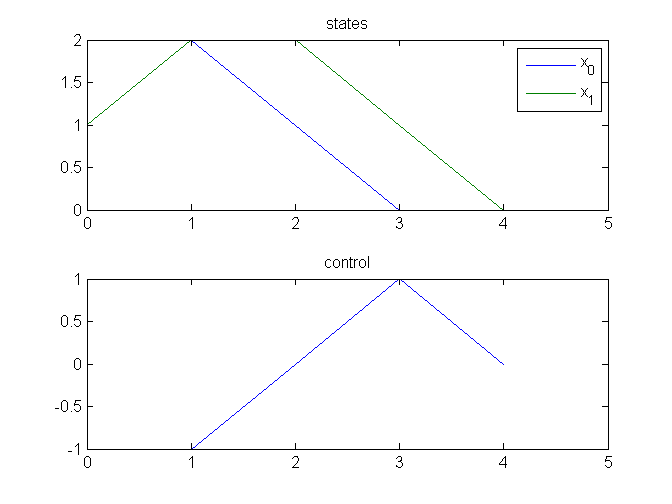TomSym MPC example with TomSym.
|
This page is part of the TomSym Manual. See TomSym Manual. |
This is an example of MPC for a linear, time-invariant system, illustrating how to use sym2prob and setParameter with tomSym for repeatedly solving the same optimization problem.
Note: This example code contains two alternative ways of setting up the problem. If you use this code as a basis for your own MPC controller, then you should probalby delete the "if 0" statement, and only keep the "else" part.
Reference: The problem definition is taken from the "Standard MPC" example in the YALMIP documentaion by Johan Löfberg. http://users.isy.liu.se/johanl/yalmip/pmwiki.php?n=Examples.StandardMPC
% Model data
A = [2 -1;1 0];
B = [1;0];
nx = size(A,2); % Number of states
nu = size(B,2); % Number of inputs
% MPC data
Q = eye(2);
R = 1;
N = 4; % Number of time-steps
% Make the initial state a symbol, so that we can use it as a parameter
% later.
x0 = tom('x0',nx,1);Problem Setup
This example shows two ways of setting up the model. Change "if 0" to "if 1" to try the other one.
if 0
% The more intuitive way to write the model involves a for-loop:
u = cell(N,1); % Preallocate empty cell array.
constraints = cell(N,1);
objective = 0;
x = x0;
for k = 1:N
u{k} = tom(['u' num2str(k)], nu, 1);
% The symbolic expressions for x and the objective will grow inside
% the loop, so at the last iteration, they will be quite large.
% Remove the semicolons from the following lines to see how the
% expressions grow.
x = A*x + B*u{k};
objective = objective + norm(Q*x,1) + norm(R*u{k},1);
constraints{k} = { -1 <= u{k} <= 1, -5 <= x <=5 };
end
else
% A better way to solve the same problem:
% Making all x(k) a decsion variables is numerically more sound, even
% though it makes the number of unknowns larger.
x = tom('x',nx,N);
% Make the first column of u a separate symbol for compatibility with
% the above variation of the code.
u1 = tom('u1',nu,1);
uk = tom('uk',nu,N-1);
u = [u1 uk];
% Matrix-matrix multiplication is equivalent to looping over the
% columns of the second matrix and doing matrix-vector multiplication.
constraints = {
x == A*[x0 x(:,1:N-1)] + B*u
-1 <= u <= 1
-5 <= x <= 5
};
objective = sum(vec(abs(Q*x))) + sum(vec(abs(R*u)));
endCompile the sybolic problem into a Prob structure
[objective, constraints] = rewriteV(objective, constraints);
ptype = tomDiagnose(objective, constraints);
Prob = sym2prob(ptype, objective, constraints);Simulate a trajectory
Now that a Prob structure has been created, we can run the optimizatino multiple times without the overhead of processing symbols.
Ns = 5; % Number of steps to simulate
xt = zeros(nx,Ns+1);
xt(:,1) = [2;1];
ut = zeros(nu,Ns);
for i = 1:Ns
Prob = setParameter(Prob, x0 == xt(:,i));
Result = tomRun('snopt',Prob,0);
solution = getSolution(Result);
ut(:,i) = solution.u1;
xt(:,i+1) = A*xt(:,i) + B*ut(:,i);
end
subplot(2,1,1);
plot(0:Ns,xt');
title('states');
legend({'x_0','x_1'});
subplot(2,1,2);
plot(0:Ns,[ut NaN(nu,1)]');
title('control');Get rid of any temporary m-files created.
This example results in a linear programming, so no m-files are created. Cleanup is therefore striclty not needed, but we include it in case we want to modify the code to use a nonlinear model later. (Remove these lines if you want to keep the Prob structure after the script has finished.)
tomCleanup(Prob)
clear Prob